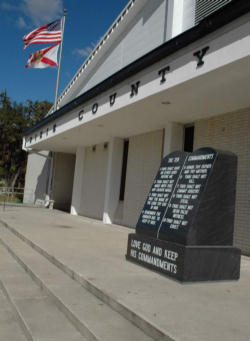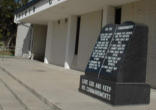On July 15, 2011 the United States District Court for the Northern District of Florida ordered that a large Ten Commandments monument – paid for privately by a local businessman and displayed since 2006 – be removed within thirty days from the front steps of the Courthouse.
Mat Staver, the founder and chairman of The Liberty Counsel, Dean and Professor of law at Liberty University School of Law and Director of the Liberty Center for Law and Policy, represented those who defended the display of the Ten Commandments outside of the Courthouse in Florida. He is a good lawyer and a good and courageous man. His legal position was correct.
The Court explained how they viewed the issue in these words, “whether a five-foot, six-ton granite monument on the front steps of the Dixie County courthouse, displaying the Ten Commandments as well as directing all viewers to “LOVE GOD AND KEEP HIS COMMANDMENTS,” violates the Establishment Clause of the First Amendment to the United States Constitution.” Then, in a confusing opiion, simply decided that it somehow did. They were in error.
The Court awarded one dollar to the ACLU in nominal damages. Howard Simon, the executive director of the ACLU of Florida said to a local paper, “We hope that Dixie County officials will find a permanent place for it at a church or other house of worship, which is the appropriate place for religious monuments.”
Mat Staver is the founder and chairman of The Liberty Counsel, Dean and Professor of law at Liberty University School of Law and the Director of the Liberty Center for Law and Policy. He represented those who defended the display of the Ten Commandments outside of the Courthouse in Florida. He is a good lawyer and a good and courageous man. Furthermore, he is correct both from a moral and a legal perspective in this case and intends to appeal the matter.
He responded to the loss with these words, “This is only the first step in a march to the United States Supreme Court. Since 2005, we have won every Ten Commandments case except one. We are ready to return to the Supreme Court. The ACLU has shown in three separate losses at the court of appeals that they have lost the High Court on this issue and they are reluctant to return.”
On Monday January 4, 2011, a three judge panel of the United States 9th Circuit Court of Appeals filed its opinion in the “Mount Soledad Cross Case”, Trunk v. City of San Diego. Those black robed justices held that the Mount Soledad cross which had stood since 1913 had somehow now become a violation of the Establishment Clause of the First Amendment to the United States Constitution.
All who are concerned about religious freedom in the United States should watch these cases, and others like them, with great concern. As a constitutional lawyer I have long questioned the current establishment clause law in our Nation. In 1992 I wrote a law review article entitled “In the Wake of Weisman: The Lemon Test is Still a lemon but the Psycho-coercion Test is more bitter Still”.
In that article, after tracing the history of the interpretation of the Establishment clause of the First Amendment to the US Constitution and the developments of the last few decades, I predicted the insanity that would follow from the efforts of the Supreme Court to apply the so called “Lemon Rule” (named after the Courts 1971 opinion in Lemon v Kurtzman) and it’s ever expanding “interpretations” and permutations. Insanity is precisely what has occurred.
We are experiencing a judicial ping pong game; incomprehensible opinions requiring a showing that religious symbols have a “secular” purpose – as though religion and the common good are mutually exclusive. Federal Judges make up their own rules by which they decide whether a religious symbol will be allowed to stand on public land or in a public building. There is not even a pretense that the actual words of the Establishment Clause have any effect in this new world of the judicial oligarchy.
 The Establishment Clause is best understood as an “anti-establishment” clause. It was intended to prohibit the “establishment” of one particular religion – in the sense of a Federal or State sponsored Church which mandated adherence from unwilling citizens. The American founders fled coercive approaches to religion which compelled adherence to a particular sect. Yet, they were not anti-religious.
The Establishment Clause is best understood as an “anti-establishment” clause. It was intended to prohibit the “establishment” of one particular religion – in the sense of a Federal or State sponsored Church which mandated adherence from unwilling citizens. The American founders fled coercive approaches to religion which compelled adherence to a particular sect. Yet, they were not anti-religious.
They were assuredly not against religious symbols or religious expression. Our history is filled with them. Or, more accurately, it once was. Religious symbols are no longer seen as a wonderful sign of the history of the West and the American founding by the new Judicial Oligarchs. Rather they are seen as a threat to the secularist order. When they are allowed they must be demonstrated to have been eviscerated of any religious meaning and somehow thereby rendered “secular” and acceptable.
The U.S. Supreme Court handed down two opinions in “Ten Commandment cases” on June 27, 2005 which sent another convoluted message. The Justices (at least five of them) upheld a display of the Ten Commandments on public land if the display is placed within the context of other displays that speak to the history of the Nation. At least that seemed to be the practical result of the Texas case which involved the “constitutionality” of the placement of a six foot granite monument of the Ten Commandments on the grounds of the Texas State Capitol.
However, the Court also held that some displays of those same commandments, with the very same content, cannot adorn the walls of a courthouse, at least if they look like ones which hung in Kentucky. It appears that if the Ten Commandments are placed within the context of other codes governing human behavior, such as they are in the display hung right in the U.S. Supreme Court, they may be permissible.
The current state of “Establishment Law” Jurisprudence is abysmal. This was noted in a dissent in the case emanating from Kentucky where Justice Antonin Scalia wrote: “What distinguishes the rule of law from the dictatorship of a shifting Supreme Court majority is the absolutely indispensable requirement that judicial opinions be grounded in consistently applied principle.”
There are no discernible principles. The Chief Justice was also correct in his comment in the Texas case when he opined: “Of course, the Ten Commandments are religious – they were so viewed at their inception and so remain. The monument therefore has religious significance… Simply having religious content or promoting a message consistent with a religious doctrine does not run afoul of the Establishment clause.”
The latest decision out of Gainesville, Florida is an example of growing governmental hostility toward religious faith and religious symbols in the public square. The effort to scrub the public square of such religious expression and symbols is a threat to religious freedom, runs contrary to our founding documents, and is unfaithful to our history as a free people. It also represents an incorrect application of the Establishment Clause, found in the First Amendment to the United States Constitution. It is a form of religious cleansing which threatens the foundations of our freedom.
This Florida opinion demonstrates that the 2005 Supreme Court decision of Van Orden v. Perry, a ten commandments case, made the illogic of current Establishment Clause Jurisprudence even more pronounced in the United States. Now, even the convoluted trail left by the Lemon case and its progeny can be abandoned by a Court, under the ruse of an “exception” to the Lemon analysis, only to be replaced by judicial whimsy.
Federal Judges seem at times to make up their own rules by which they decide whether a religious symbol will be allowed to stand on public land or in a public building. There is not even a pretense that the actual words of the Establishment Clause have any effect in this new world of the judicial oligarchy. It is essential that we reclaim the “Separation of Powers” doctrine and rein in Federal Judges and Courts.
Religious faith and the values informed by faith serve and promote the common good. Religious freedom is a fundamental and basic human right which must be secured and protected by law in truly free Nations. Rightly understood and applied, religious freedom means a freedom for religious expression; not a removal of such expression from public places.
Efforts to remove the Ten Commandments reveal the current imbalance in our allegedly co-equal branches of government. They also point out the importance of judicial appointments and cry out for a new generation of lawyers. Religious cleansing is a threat to the future of all freedoms.

